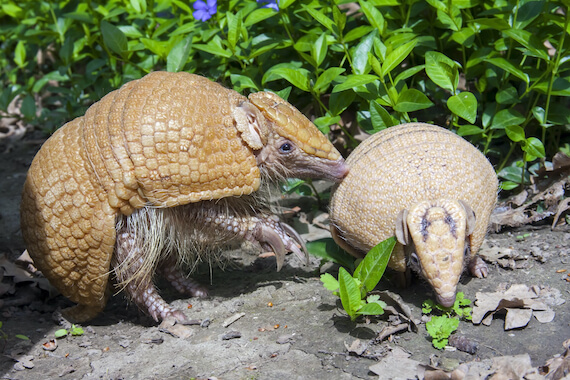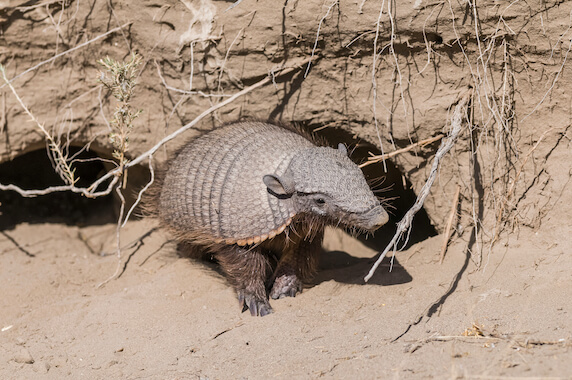
| Kingdom | Animalia |
| Phylum | Chordata |
| Class | Mammalia |
| Superorder | Xenarthra |
| Order | Cingulata |
| Family | 2 families |
| Genus | 9 genera |
| Species | 21 species |
| Niche | Insectivorous burrowing armored mammal |
| Length | 5.1 – 59 inches (13 – 150 cm) |
| Weight | 0.19 – 119 lb (85 – 5400 g) |
| Lifespan | 12 – 15 years |
| Social Structure | Solitary |
| Conservation Status | Species vary from least concern to vulnerable |
| Preferred Habitat | Tropical and subtropical environments |
| Average Litter Size | 1 – 8 |
| Main Food Item | Insects and grubs |
| Predators | Wild cats and canids, black bears, raccoons |
The Basics
The armadillo is a group of 21 species of armored placental mammal native mainly to tropical and subtropical regions of Central and South America. One species, the nine-banded armadillo, is also found in the United States as far west as eastern New Mexico and as far north as southern Nebraska. Armadillos live in a wide range of habitat types including rainforests, grasslands and semi-deserts.
Armadillos are characterized by a leathery armor shell that covers the back, head, legs, and tail of most species. The 21 species of armadillo vary greatly in size, from the pink fairy armadillo that is roughly the size of a chipmunk to the giant armadillo that is the size of a small pig. Armadillos also vary in color, with different species exhibiting brown, black, red, gray, salmon or yellowish coloring. While some armadillo species have nearly hairless shells, others have long coarse hairs that project from their shells.
In common with the other two members of the Xenarthra superorder, the sloths and anteaters, armadillos have low body temperatures of 91–97 °F (33–36 °C) and low basal metabolic rates that are only 40 – 60% of that expected for placental mammals of their mass. This, combined with their lack of fat stores, means that armadillos are restricted to living in warm regions and entire populations can be wiped out by a single cold spell.

Ecology and Reproduction
Armadillos feed mostly on invertebrates including insects and grubs. Certain species such as the generalist nine-banded armadillo feed on a variety of prey types and even eat amphibians and reptiles during winter. However, other species such as the giant armadillo have highly specialist diets consisting primarily of termites. Some species might also supplement their diet with plants, fruits and carrion on occasion.
Armadillos have poor eyesight, so use their sense of smell to detect prey. These animals have a number of adaptations for capturing prey, such as their sharp claws used to dig invertebrates out of the ground and their long, sticky tongues used to extract ants and termites from the tunnels in their nests. Armadillos are nocturnal and tend to hunt at dawn and dusk. They spend daylight hours inside their burrows, where they sleep prolifically for up to 16 hours per day.
Armadillos use their sharp claws and strong legs to create their burrows, which can be up to 20 feet (6 meters) long, extend up to 5 feet (1.5 meters) underground and have up to 12 entrances. When threatened, armadillos often retreat into their burrows and certain species can flex their shell to wedge themselves in so tightly that they cannot be pulled out. The pink fairy armadillo has a slightly different strategy and uses its shell to plug the entrance of its burrow so nothing can get in. Only one genus, which comprizes the two species of three-banded armadillo, is able to completely roll itself into a ball for protection from predators.
Gestation in armadillos is 60 – 120 days long depending on the species. In the case of the nine-banded armadillo and a few other species, young are not usually born until at least 8 months after mating due to delayed implantation. This is where the fertilized egg is not implanted in the uterus for several months after mating has taken place. Delayed implantation in armadillos might be an adaptation to ensure that young are born at a time of year when the climate is most favorable. Different armadillo species give birth to between 1 and 8 young, which are born with soft skin that hardens after a few weeks.

Fun Facts about Armadillos
Although its armor might seem like the armadillo’s most remarkable feature, these fascinating animals also exhibit a number of other traits that provide examples of interesting biological concepts.
Ecosystem Engineers
Each species of armadillo digs its burrow to accommodate its specific size, but often armadillos are not the only animals that make use of their burrows. In fact, a wide range of species are known to use giant armadillo burrows, most commonly as a refuge from predators or extreme temperatures. Certain animals including wild pigs, anteaters, tapirs and pumas also use the sand mounds created by digging borrows as resting places. Other species, including small rodents, lizards, racoons and ocelots use either the sand mounds or the entrances to burrows as places to search for prey displaced by the burrowing process.
When a giant armadillo digs its burrow, it alters its physical surroundings, hence creating or modifying habitats for a wide range of animals that live in the same location. As a result, giant armadillos are considered to be ecosystem engineers. Another example of an ecosystem engineer is the beaver, which physically modulates the water flow of streams when building dams, creating ponds and wetlands in the process. Ecosystem engineers play a vital role in their ecosystems, thus if they were to decline in number this could have significant consequences for the habitats they modify or create and the many animals that make use of them.

Polyembryony
The phenomenon of a sexually produced embryo splitting into two or more is called polyembryony and results in the birth of multiple genetically identical offspring. Although this occurs only occasionally in humans when twins or triplets are born, it is the norm for a number of animals including parasitic wasps, some flatworms and various aquatic invertebrates. However, the only vertebrates known to always produce polyembryonic young are the species of the armadillo genus Dasypus. The most well-studied species in this genus is the nine-banded armadillo, which always gives birth to four genetically identical offspring.
It is thought that polyembryony evolved in this genus due to the oddly-shaped uterus of armadillos that only allows for implantation of a single blastocyst. In all other armadillo genera, this has led to females typically giving birth to only one offspring at once. However, Dasypus species have seemingly evolved to bypass this constraint and increase their reproductive success via polyembryony.
Armored Mammals
Armadillos are the only mammals with a protective armor formed by plates of dermal bone. This is the same type of bone that forms much of the skulls and jaws of vertebrates, as well as the shells of turtles and tortoises. The plates of bone are covered in small overlapping epidermal scales called scutes, which are composed of keratin. Most armadillo species have rigid armor covering their shoulders and hips, whilst their back and flanks are covered with a number of armored bands separated by flexible skin. The top of the head, upper limbs and tail are also usually covered in armor. However, the underside is never armored and is only covered by soft skin and fur. Although the the armor of armadillos likely evolved to provide protection, most species don’t make use of it, instead choosing to flee when in danger.
